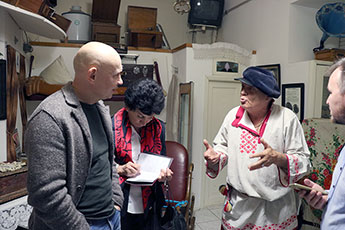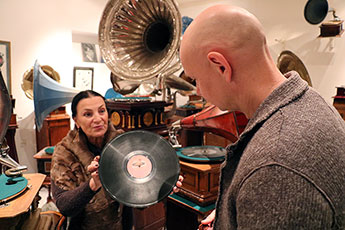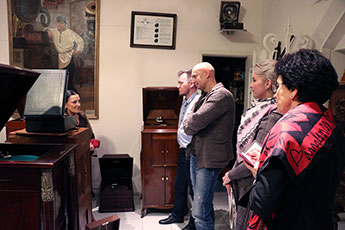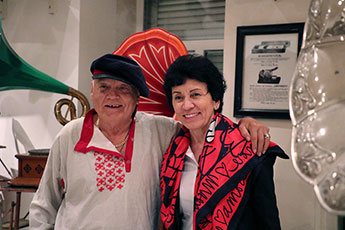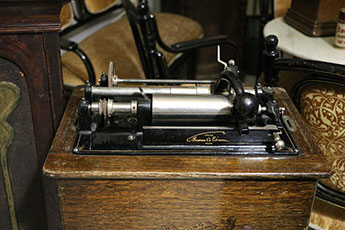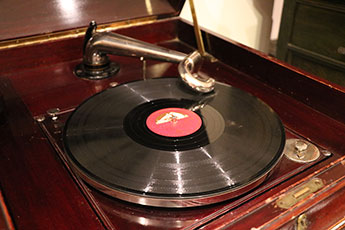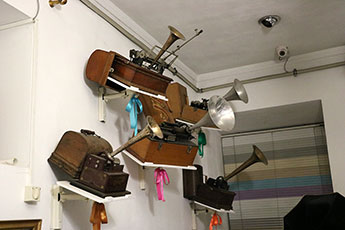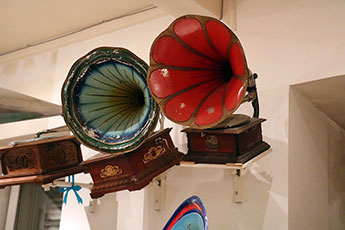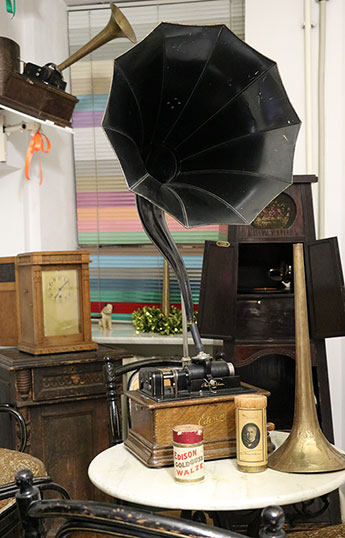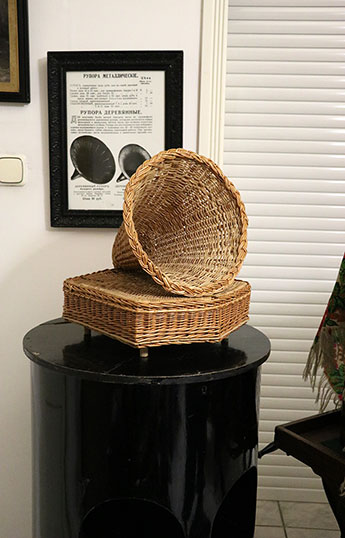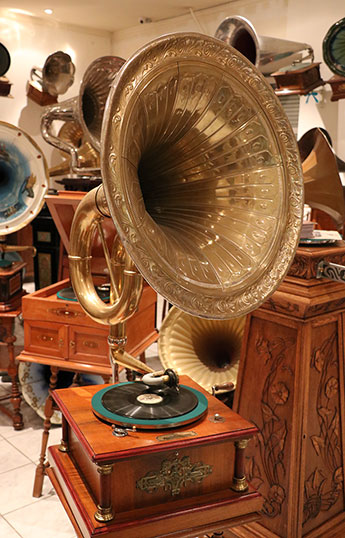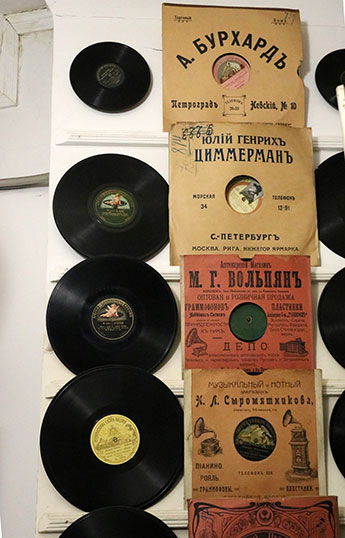Visiting the Museum of Gramophones and Phonographs
The founder and owner of the museum, Vladimir Deryabkin, is a former circus performer, trainer, and collector. Lyudmila Deryabkina, the guide and Vladimir’s spouse, talks about the exhibits, the founder, and how they manage the museum.
As a performer, Vladimir Deryabkin has toured many cities around the world. The idea to create a collection of gramophones came to him after reading ‘The Art of Captured Sound’ by L.F. Volkov-Lannit. What caught his eye was a simple line, which read, ‘...if someone decides to build up a collection of gramophones, this will make a unique possession which will become valuable with time…’
Vladimir bought his first gramophone in Krasnodar back in the day when he worked with another performer on the reprise ‘In the Tavern’, for which they needed a gramophone. Vladimir was eager to get a real one. One day, as he was walking down a street in a private sector of Krasnodar, he saw an old man standing near a house and selling something. Vladimir approached him and asked where he could get a gramophone, and the man said he was actually selling his gramophone, which he stored in the attic. This is how the story of this unusual collection began.
Over the 30 years since it came into being, the unique collection has grown a lot. Many regions have joined the list. It will takes hours to mention and tell the story of each and every exhibit on display, and to view all of them in detail, one may easily need a couple of days.
Lyudmila’s story carried us away into the world of sound. Absorbed in it, we became unaware of the passing time. We wanted to take a careful look at each exhibit and, of course, we wanted to ‘feel’ the items. It is impossible to describe emotions that arise when you get to touch musical instruments which belonged to such legendary people as Russian opera singer Feodor Chaliapin, theatre director and actor Konstantin Stanislavsky, female singer Nadezhda Plevitskaya, or opera singer Ivan Yershov. One of the rooms even has a phonograph which belonged to none other than Lev Tolstoy.
Upon entering the hall, a visitor is welcomed by portraits of Charles Cros, the first man to propose a means of reproducing sound, Thomas Edison, the inventor of the phonograph, and Emile Berliner, the creator of the gramophone. Thomas Edison was so proud of his invention that he kept bragging that even Lev Tolstoy had his gramophone — who would miss a chance to advertise.
As we strolled the three spacious halls of the museum, we could see rare, centuries-old objects from America, France, Germany, and many Russian cities. The museum deserves a lot credit for the hard work its staff has put in to preserve and repair the numerous exhibits. The items were obtained during the tours and stored in Vladimir’s apartment in St Petersburg, which at the time bore the name of Leningrad.
One day, there was no more room left. This made Vladimir think of opening his own museum. Each year, the troupe spent almost 11 months on the road and only one month at home in an apartment stacked with musical devices floor to ceiling. Now that it was time to say goodbye to the circus life and finally retire, they had no place to live.
Luckily, Lyudmila Belova, who was commandant (governor) of the Peter-and-Paul Fortress, stepped in. She offered great help finding a place to accommodate the collection and complete a basic renovation on the building. Thanks to her determination and hard work, the Museum of Gramophones and Phonographs was opened to the public in 1997.
Apart from the antique gramophones and phonographs, the museum offers a wide selection of records dating back to as early as 1917. The display has rare accessories for gramophones which were popular back in the day, and even has a real music box. Most of the exhibits were given a second life thanks to the care and professionalism of the conservators.
The collection boasts vintage electronics by the world’s biggest and oldest brands, such as Julius Heinrich Zimmermann, Rebikov, and Burkhart. All parts — wood, aluminum, and other ones — we fixed and the devices were brought back to life.
Each device is decorated with antique designs, various engravings, stained-glass, and unique painted panels. They are truly works of art. The stories told by the guide help appreciate and navigate through the large exposition.
The tour finishes with a nice treat. The last room welcomes you for a cup of delicious tea and a table full of sweets. The building is not very big on the inside, but has an interesting and vibrant living room. The whole interior design concept was developed by Vladimir and Lyudmila without any help from the outside, thanks to which the building assumed its individual character and acquired a distinct atmosphere.
The Museum of Gramophones and Phonographs is the third largest museum of its kind. ‘After the museum was opened, we got a visit from the chairman of the Phonograph Society from Stuttgart, who was really surprised. He knows all big names in the world of collecting but had never heard of the museum in Saint Petersburg. He also told us that we ranked third, Holland was second, and South Korea was first,’ says Lyudmila Deryabkina. Mr Son, the owner of the largest gramophone museum, Charmsori Gramophone & Edison Science Museum, paid a personal visit to the museum after learning about it on TV, and was fascinated by its collection.
The atmosphere inside the museum is so unique and homelike that you want to come back again and again to spend another great day full of culture.
The hospitality of the Deryabkin family leaves a very positive lasting impression. But it is sad to hear that the museum has to literally survive on what they make from selling tickets, organizing events for children, and throwing tea parties. ‘We have just enough money to pay the rent and the bills,’ says Lyudmila. When the things get really tough, they turn to their son Vladimir for help. He followed his father’s career and became a circus performer. But he too has his limits. Once, says Lyudmila, they had to sell an exhibit — an antique music box — to fund a building renovation.
Today, there are somewhat 300 such ‘folk’ unusual museums in Russia, which would have gone extinct had it not been for the sheer enthusiasm and devotion of their founders and owners. This is something that is important to understand and to get across to the officials in order to preserve the invaluable cultural heritage embodied in the exhibits which literally store our memories.
Without such unique collections, future generations will not be able to learn about our ways, our culture, and our mindset. The link between us will be broken, and there will be no opportunity to share our collective memory or cultural heritage. Civilization as it is would be impossible, nations would cease to exist. Every person should think of what can be done to preserve our cultural legacy.
For the largest part ill handwriting in the world is caused by hurry.
(Lewis Carroll)
